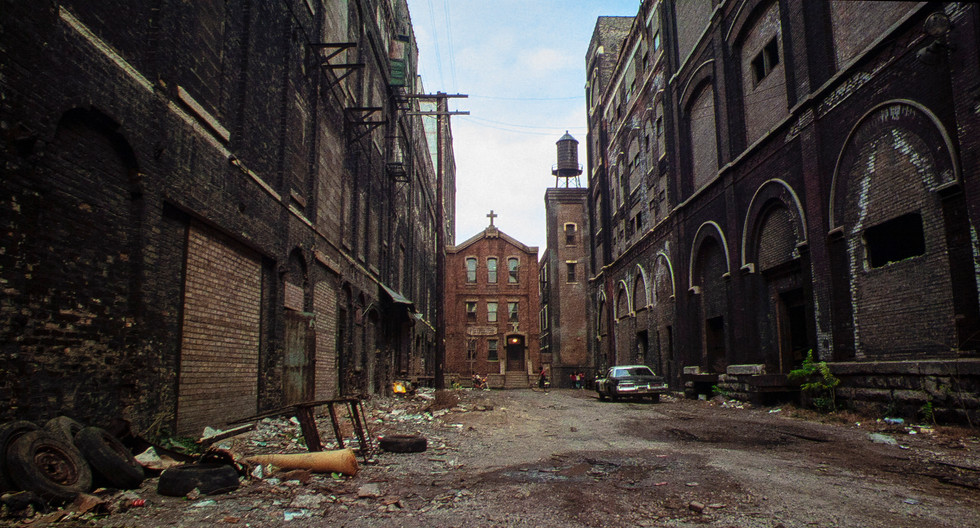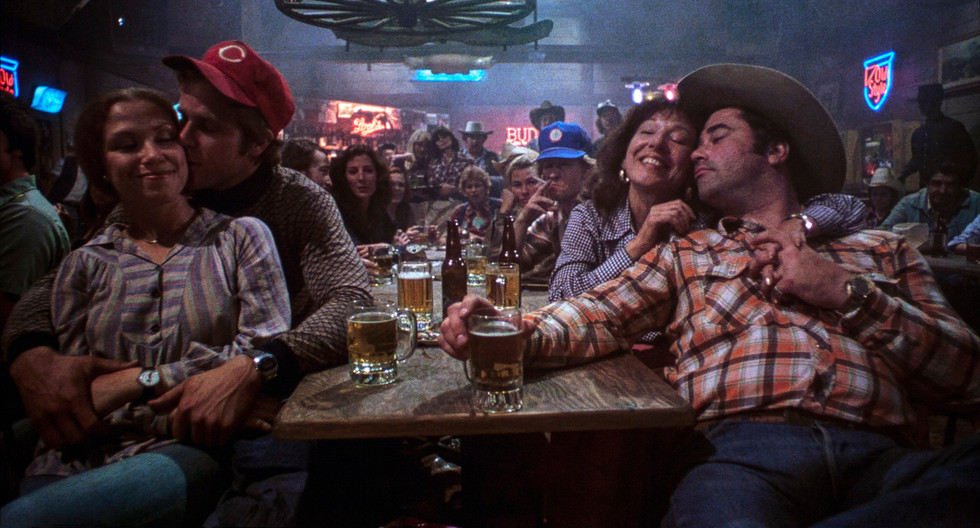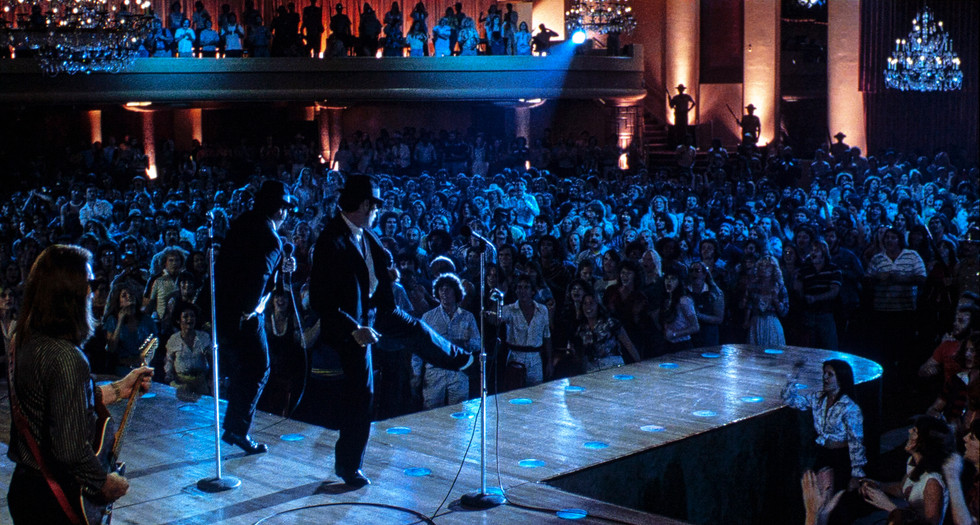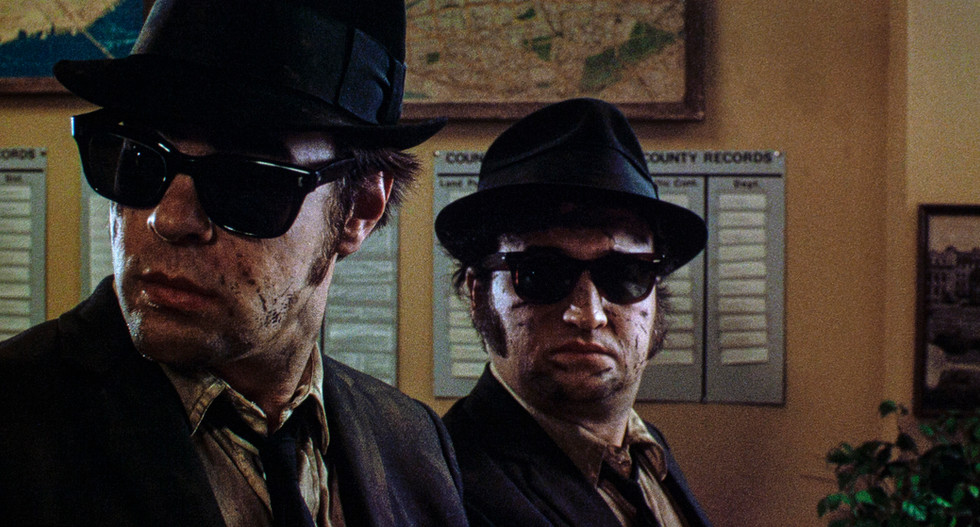“The Blues Brothers” brings the house down in 4K Ultra HD
- Bill Kelley III

- May 21, 2020
- 7 min read
Updated: Feb 13, 2021
4K ULTRA HD REVIEW / HDR FRAME SHOTS

The Blues Brothers - Elwood (Dan Aykroyd) and Jake (John Belushi) arrive at the Triple Rock Baptist Church to hear Rev. Cleophus James played by the 'Godfather of Soul' James Brown.
(Click an image to scroll the larger versions)
“THE BLUES BROTHERS”
4K Ultra HD, Blu-ray, Digital copy; 1980, R for language and violence; Streaming via Amazon Prime Video, Apple TV, FandangoNOW, Google Play, Vudu, YouTube
Best extra: 13-part “Stories Behind the Making of” (4K disc)
FOR FOUR DECADES, The Blues Brothers – Jake (John Belushi) and Elwood (Dan Aykroyd) – have been on a mission from God.
To celebrate the anniversary of the film and its characters, Universal Studios has scanned the original 35mm camera negative (theatrical cut and 15-minute longer extended cut) and remastered the sound with outstanding results for a new 4K Ultra HD release.
The story began late one night in Toronto during the 1970s. Belushi was in Canada trying to steal talent from the Second City TV show for the National Lampoon Radio Hour, when he decided to visit Aykroyd’s after-hours speakeasy. They started playing old blues records, Aykroyd says in the 13-part documentary carried over from previous editions. It “reacquainted [Belushi] with blues.” Howard Shore, who eventually became the musical director for “Saturday Night Live,” and film composer for “The Lord of the Rings” and “The Hobbit” trilogies, was also there that night. The three decided to “Put a band together,” Aykroyd says. Shore agreed: “Yeah, you can call yourselves The Blues Brothers.”
Joliet Jake and Elwood Blues made their debut during SNL warm-ups, “To explore the music, have a little fun with it, and make the audience laugh,” Aykroyd explains. The duo first appeared live singing “Soul Man,” with Carrie Fisher hosting the show that night in 1978. Next, Steve Martin asked the guys to open his comedy act at the Universal Amphitheater in L.A., which was filled with the Who’s Who of Hollywood. “No one was prepared for the phenomenal success,” says John Landis, who directed the film and Belushi in “Animal House.” The live performance recording became an LP that sold over two-million copies.
(1) Prisoner 7474505B - Jake Blues is released on parole, three out of five from the Joliet Correctional Center. His brother Elwood is there with the new Bluesmoblie. (2) The brothers drive to Chicago's West Side, to Saint Helen orphanage and visit Sister Mary Stigmata (Kathleen Freeman), which leads to a beat down. (4) Curtis (Cab Calloway) the Blues Brothers former manager tells how the orphanage owes $5,000 in back taxes that are due in 11 days. If it's not paid they plan to sell the building to the Board of Education.
The band itself was handpicked by Belushi and Paul Shaffer, SNL keyboard player and maestro, with SNL members Tom ‘Bones’ Malone, and the show’s three horn players. Then they called for R&B guitar greats Steve ‘The Colonel’ Cropper, Donald ‘Duck’ Dunn and Matt ‘Guitar’ Murphy, who was swappin’ licks with Johnny Winter at the time. Drummer Willie Hall from Isaac Hayes’ band was selected, giving the band a distinct Memphis rhythm section, along with the New York horns. Strangely, Shaffer missed the film’s band lineup because of a contractual dispute with SNL. “We weren’t the greatest frontmen, but we provided energy and a package for the band,” Aykroyd says. He called the group, “Chicago electrified urban blues band, fused with the Memphis Staz/Volt movement.”
After the success of the LP, Aykroyd started to develop backstories for the two brothers. Jake and Elwood grew up in a sadistic West Side orphanage, became homeless and led a life of crime, “Because they never really had a family,” he says. His original script ballooned to 324-pages, with a story for every band member. “It was pretty incoherent,” Landis points out. “But it had great ideas, epic characters, and real respect for the music.” He reveals they began shooting before the script was even finalized.
Landis has been frustrated for years because many people don’t consider “The Blues Brothers” a musical, “Which makes me nuts, ‘cause it has more music than most musicals.” He and cinematographer Stephen M. Katz, both fans of classic Hollywood musicals, kept that vision for the project.
“What you can’t hide and you can’t discredit is their sheer passion and enthusiasm for the rhythm and blues.” – John Landis
(1&2) James Brown as Rev. Cleophus James sings the gospel favorite “The Old Landmark,” as the congregation joins with dancing and singing. (3) A ray of sunshine hits the church and Jake, which gives him the mission to get the band back together to raise funds for the orphanage. (4) Aretha Franklin plays the Soul Food diner owner, who sings "Think" to her man Matt Murphy, former guitar player for the brothers. (5&6) After being pulled over for running a changing traffic light, Elwood drives away which leads to the first of many car chases.
Getting the likes of Aretha Franklin, John Lee Hooker, Ray Charles, James Brown, and Cab Calloway was easier than expected since Ray Charles was the only one who had a regular gig at the time. It was a challenge filming Franklin in the soul food diner, trying to lip-synch to the playback track to her own classic, “Think.” She was one of the greats who didn’t sing a song the same way twice. “So it’s quite great if you’re seeing her live, but trying to shoot her is a huge pain,” Landis says. For James Brown’s scene at the church they ended up recording his vocals live.
“It’s 106 miles to Chicago. We got a full tank of gas, half a pack of cigarettes, it’s dark, and we’re wearing sunglasses.” – Elwood Blues
Filming in downtown Chicago was mostly accomplished on Saturday and Sunday mornings, using hundreds of assistants to patrol every intersection, alley and door to make sure someone didn’t walk into the scene, where stunt cars raced over 100 mph. It was the first movie production in the city after the death of Mayor Richard Daley. For decades he would not allow movies to be filmed in the city. The decree stemmed from an episode of “M Squad,” where a Chicago cop accepted a bribe.
The final chase in downtown ended up using 60 Illinois State Police cars, 42 Chicago cop cars, 17 ambulances, 150 National Guardsmen, 60 Chicago cops, 350 guns and 150 batons, four Sherman tanks, and three helicopters.
So production got a little out of hand for Landis and the producers who spent $30 million, when their budget was only $12 million. Still, the worldwide box office topped $115 million, earning the No. 2 of the year right behind “Star Wars: The Empire Strikes Back.”
(1) Elwood, Jake, and the band members go to Ray's Music Exchange to get their instruments where Ray Charles sings “Shake a Tail Feather,” which leads to dancing in the streets. (3&4) The band finally gets a gig at Bob's Country Bunker, where wire mesh has been installed to protect the band from beer bottles thrown by the customers. (5) Boys at the orphanage. (6) Jake and Elwood hit a local beach to announce their concert at the Palace Hotel.
The 4K disc includes a carried over salute to John Belushi, a guy from Wheaton, Illinois, who married his high school sweetheart. “He wanted to play football, originally, when I met him,” says Judy Belushi-Pisano. But, at the same time, he had an interest in theater. “I thought he’d probably be like Frank Sinatra,” she says. “He promised me if he couldn’t make a living with acting by the time he was 30 that he would quit and get a real job.”
Belushi died at 33, in March of 1982, after starring in seven movies, and won an Emmy Award as a member of the writing team for an SNL episode with guest host Sissy Spacek. On April Fool’s Day, 2004, his brother Jim and widow Judy celebrated the placement of Belushi’s Star on the Hollywood Walk of Fame.
VIDEO
The original camera negative was filmed in an open matte, with extra space above the actor's head and below. It was scanned in 4K, and then digitally matted to its original theatrical aspect ratio of 1.85:1. Natural film grain dances across the screen in complete cinematic style. It stays controlled even during the composite shot when the ray of light hits the church. Sharpness and clarity are full of detail from close-ups to wide shots as when the brothers drive the Bluesmobile down the alleyway toward the orphanage at Saint Helen of the Blessed Shroud. Viewers can count every single brick on the buildings.
HDR10 toning showcases exceptional contrast levels on the theatrical cut from deep blacks to controlled highlights. However, highlights in the extended cut footage are slightly blown out and colors are less saturated. Complexions look natural among the diverse cast, while the rest of the cityscapes appear true and accurate.
HDR10+ toning was said to be available on the disc, but neither the jacket nor disc includes its trademark. Our projector can’t produce that form of HDR toning, so we can’t confirm its absence or mislabeling.
(1) Elwood and Jake are late for the Palace Hotel concert, and Curtis provides the perfect warm-up as Cab Calloway sings his own jive anthem “Minnie the Moocher.” (2&3) The Blues Brothers hit the stage with their own brand of blues. (4) Carrie Fisher plays Jake's bitter fiancée. (5) Jake shows his puppy eyes and she says, "Oh, Jake. Jake honey."
AUDIO
The new DTS:X eight-channel soundtrack is a major bump in quality from previous editions, pushing effects and music to height speakers – especially during musical numbers. Bass response really kicks into action with Willie Hall’s percussion beats. The 11 songs on the LP, which sold over 4 million copies worldwide, are unforgettable. They include Jake singing Taj Mahal’s blues classic “She Caught the Katy,” the “Peter Gunn Theme,” The Blues Brothers rendition of the Spencer Davis Group hit “Gimme Some Lovin’,” Ray Charles singing “Shake a Tail Feather,” James Brown wailing on gospel favorite “The Old Landmark,” Aretha Franklin on “Think,” Cab Calloway delivering his own jive anthem “Minnie the Moocher,” and The Blues Brothers comical take on the “Theme from Rawhide.”
Over the years this comedy-musical continues to be an entertaining experience with a fabulous soundtrack. The new 4K remaster only adds to the fun.
— Bill Kelley III, High-Def Watch producer
(1) The final car chase with dozens of police cars. (2) Elwood and Jake enter the Cook County Assessors office to pay the $5,000 back taxes. (3&4) Elwood and Jake are arrested and sent back to prison, and the band covers one of Elvis Presley's biggest hits "Jailhouse Rock."






















































Comments